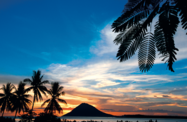Having topped its goal of seeing 8m visitors last year, Indonesia is now targeting 9m tourist arrivals for 2013. A series of new and ongoing initiatives establishing niche segments is expected to aid in that goal.
The Central Statistics Agency reported in early February that the number of foreign tourists reached 8.01m in 2012, an increase of 10.54% over 2011. In December alone, the number of foreign arrivals increased 5.86%, to 766,966, over the same month in 2011. Revenue figures for the year are not yet available but the Tourism and Creative Economy Ministry estimates Indonesia received $9.1bn last year, a 5.81% increase on the $8.6bn seen in 2011.
The island of Bali, which has long been Indonesia’s tourism star, recorded at least 2.9m visitors last year, passing the target of 2.8m. As well as its core markets Australia and Japan, Bali is also a popular destination for visitors from China, which is becoming one of the world’s most important outbound tourism markets, helping drive average annual arrival growth of 10-12% over the past five years. The regional government now expects 3.1m arrivals in 2013.
Domestic tourism, however, should not be disregarded: Indonesian internal travellers made an estimated 245m trips in 2012, up 3.81% on 2011, according to official figures. Each domestic tourist spends on average Rp700,000 ($72) per trip , bringing total revenue to Rp171.5trn ($17.15bn), up 9.31% on 2011.
While much media attention on Indonesia’s investment prospects has focused on its natural resources, tourism has perhaps been overlooked as an important economic contributor. The World Tourism & Travel Council, a global industry body, estimates that the tourism and travel sector’s total contribution to GDP was Rp640.79trn ($64.07bn), or 8.8%, in 2011 and that the sector will grow by an average 6.9% per year to 2020.
The sector is now the country’s fifth-largest foreign currency earner, after oil and gas, coal, palm oil, and rubber products, according to official figures. And unlike these sectors, it is considerably less susceptible to fluctuations in global commodity prices.
To achieve continued tourism growth, Indonesia is implementing several initiatives, including developing specific promising segments, increasing connectivity and boosting the promotion of new destinations. Niches being developed include meetings, incentives, conferences and exhibitions (MICE); adventure; sports; cultural and “sharia” tourism.
Perhaps the most important upcoming event in Indonesia this year is the 2013 Asia Pacific Economic Cooperation (APEC) summit, to be held in Bali in October; 10 other Indonesian cities will also host related meetings before the event. Last year’s summit attracted 5000 delegates, including assorted heads of state.
Cultural and sporting events being lined up include the three-month Sail Indonesia regatta and the Tour de Singkarak, an annual cycling race held in West Sumatra, as well as a range of local festivals to which the tourism authorities are keen to draw attention.
“Sharia tourism”, meanwhile, is a segment that focuses on attracting a growing number of Muslim tourists. According to Rizky Handayani, the MICE director at the Ministry of Tourism and Creative Economy, the sharia sector is actually quite straightforward and requires providing facilities and amenities that Muslims seek, including halal food and the availability of places to pray.
Rizky suggests that Muslim tourists represented a market worth $126.1bn in 2011 and that the segment will grow by 4.8% per year until 2020 to reach $192bn. Indeed, Indonesia’s tourist arrivals from four significant Muslim markets – Egypt, the UAE, Bahrain and Saudi Arabia – rose 13.11% between January and November of 2012.
As part of the strategy of broadening Indonesia’s tourism offerings, officials have said that a number of newer destinations and attractions would be developed in 2013, including the volcano chain in Bromo Tengger Semeru National Park in East Java, wildlife tours to see Komodo dragons in Nusa Tenggara, cultural and environmental attractions in Sulawesi, and the coastal town of Sanur in Bali. Promotional efforts are also being stepped up, with Indonesia appearing as the official partner country at this year’s ITB Berlin, the world’s leading tourism fair.
The tourism sector has done well in 2012, despite a difficult year for the world economy, and its diversified and value-concentrated strategy could serve it well in the long term.

